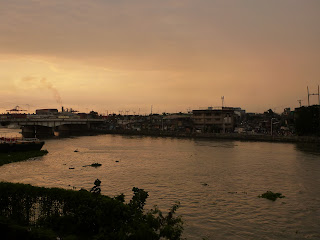Thursday, October 11, 2012
Day 353: Old Manila
I arrived in Manila in the morning and was immediately confronted with the city's transportation system. Apparently, there is no public transport connecting the airport to the rest of the city - at least none that a foreigner would be able to use without weeks of instruction. So the only way into the city is a taxi. But the weirdness continues when it comes to taxis: there are three different types. One has a fixed rate - which is ridiculously high, of course. One has a special 'airport' rate - which is twice as high as that of regular taxis. And then there are regular taxis - but these can only be found in the departures area, not the arrival zone. Seriously, is that any way of welcoming visitors?
Add to that the fact that the streets are congested day and night - if a taxi ride takes ten minutes, there will be at least an additional twenty minutes spent standing. And without decent rail-bound transportation, there is just no way to get around the congested streets. Especially coming from Mexico City and its perfect metro system, I was appalled by what Manila - a city of similar size - has to offer in terms of public transportation.
Having checked into my hostel, I was looking for a way to spend the rest of the day so I wouldn't fall prey to jet-lag by going to sleep early. So I was pleasantly surprised that the hostel offered a free walking tour of Manila's historical center, starting around noon. Our first stop - after some more public transportation, consisting of a jeepney ride and a few metro stations - was the national museum.
Going with a guide, there was not enough time to take it all in - after all, the museum offered a breakdown of all the cultural groups in the Philippines, along with items recovered from a 17th century Spanish shipwreck. The pottery in the exhibition was interesting though: the dragon decorations clearly showed a Chinese influence, a distinct difference to pottery in the Americas.
Next up was Rizal park, the biggest park in Manila. It is named after the national hero José Rizal who, by writing novels about the state of the country under Spanish reign and getting executed for that, finally started the Philippine independence movement at the end of the 19th century. This is a monument in his honor:
No visit to the historical center of Manila would be complete without Fort Santiago, the place where the Spanish held José Rizal prisoner before his execution. Today, the fort has a big Rizal shrine centered around the prison cell, showing memorabilia from his life.
The security personnel watching over the fort - and the entire historical district, in fact - were wearing old Spanish uniforms, looking a little strange to modern eyes (if not downright ridiculous... there's a picture at Wikipedia.)
The fort overlooks the Pasig river, revealing a prime view of... a shantytown:
Labels:
Philippines
Location:
Fort Santiago, Manila, Philippines



